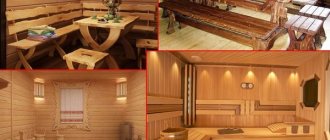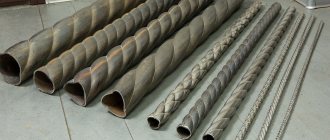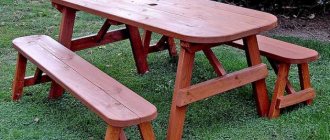DIY hammock stand
A hammock installed in the right place and in the right position guarantees a great rest. You can hang a hammock between two trees on a shady lawn, between rafters, on a porch—even in a bedroom, using straps, wall hooks, a hammock stand , or a combination of methods.
The best way is to make a hammock stand with your own hands , then you will not have problems with adjustment. At first glance, this may seem like a difficult task, but after reading the article, make sure that assembling such a structure is not a problem at all. If you have a drawing and step-by-step photographs, making a hammock stand is simple and inexpensive.
Pergola or gazebo frame
If your summer cottage has pergolas or gazebos with pillars with a diameter of at least 20 cm, located at a distance of about 3.5 m from each other, they will become ideal supports for a hammock. The roof will create natural shade and protect you from the sun's rays even on the hottest day.
Ceiling or ceiling beams
Typically, the ceilings of country houses are not designed for installing hammocks; this option can only be used if metal structures are built into the edges to enhance rigidity. You need to attach them to them or directly into the beam, if it is strong enough.
The technology is simple: install anchor rings, reinforce them with fastening nuts and hang the hammock. Before installation, assess the height and width of the room. It is advisable that there be 1.5 meters of free space to the floor and each wall.
Option for ceiling placement of hammock chairs
Under the tree
If you like to read books outdoors, you can hang a hammock under a tree. Now you will have the opportunity to take a nap after lunch in the fresh air, in the shade. Give preference to quiet, remote places so that no one will disturb you.
It is suitable only for those who live in a region with a warm climate. In rainy weather you can enjoy a good rest. On the negative side, insects will annoy you. You can protect yourself from them by hanging hammocks with a special mesh. You can also build a protective canopy yourself. This does not require special skills.
Fence posts or outbuildings
If the height of the fence allows, the pillars of its two spans, converging at right angles, can be used as fastenings. This way, the space near the fence will be put to good use, and the hammock will have enough room to swing.
Be sure to look at what to plant along the fence.
Rafter-webbing suspension system
The finished hammock is equipped with slings (straps). They are a mandatory structural part of the product. Slings are a continuation of the product. The slings include connecting elements and grips:
- rope branches;
- links;
- hooks;
- rings;
- staples;
- carbines.
Slings (straps) are made of thick rope or belt. To create one of the common variants of the rafter-webbing system, a belt 8 m long is taken. Then it is divided into 4 segments. They can be equal in length or different. If the length is not kept the same for all segments, then equal sizes are set for paired straps.
A knot is tied on the carabiner.
An adjustment bar can be used. Then the installed product will receive an aesthetic appearance and become more convenient to use.
The belt is threaded in one direction and pulled out the other.
The belt is passed through the hole in the carabiner. Then it is inserted into the adjustment bar.
The end of the belt is brought out.
The end of the belt (tail) must be fixed.
This place is stitched with dense nylon thread. Sewn with small, dense stitches. You will have to sew 3 layers. Alternatively, you can install one metal rivet.
4 straps are constructed and attached to the rim (harness) on four sides with carabiners.
The slings are tied in pairs (on both sides) to a bar horizontally located between the branches of the trees. The distance between the slings should be 40–60 cm. The length of the straps can be adjusted, giving different configurations to this piece of furniture.
To customize the seat, the front straps are made longer and the rear straps shorter.
Rafter-webbing systems allow hanging loungers to be used as chairs and swings. This type of fastening is quite reliable and less labor-intensive. There is no need to carry out complex calculations or consult drawings in the smallest detail.
Veranda or terrace
This mounting option is suitable for owners of country houses and verandas with strong walls made of brick or concrete. In order to hang a hammock, drill two holes in opposite or adjacent walls, at the required distance, insert anchor rings and reinforced carabiners into them. The longer the hammock, the higher the attachment points should be.
See also a beautiful design project for a terrace in a private house near Moscow.
You can also attach a hammock to the walls through the door frames.
We make it ourselves – easily and economically!
The hammock is quite exotic for the domestic summer resident, who, even recognizing the beneficial properties of the latter, is in no hurry to purchase it, since he considers this pleasure too expensive and troublesome to install.
Specialized stores offer quite a lot of ready-made solutions for every taste and budget, but there is an easier way to increase the comfort of relaxation at the dacha - make a hammock for the dacha with your own hands.
This is quite simple to do, and the cost of materials will be minimal.
On the open porch
The hammock harmonizes with the design of the open porch. And it doesn’t matter whether there is a canopy or a roof there or not.
The only drawback of this design is that you will have to adapt to weather conditions. In case of rainy weather or cold, you will not be able to enjoy a relaxing holiday. However, in sunny weather you can sunbathe in comfort.
Iron pillars
To install a hammock you will need two iron posts with a diameter of 15-20 cm, metal fasteners and cement mortar. The pillars must be installed at the same distance as the wooden beams, holes for them must be dug in the ground at least a meter deep, and concreted. After the solution has hardened, you can attach the hammock in the usual way.
How to hang a hammock in an apartment: attaching it to the walls
Many people strive for comfort and reconnection with nature, even while in their apartment. When buying a hammock, few people think in advance about where and how to attach it. An incorrectly chosen location and poor-quality fastenings can lead to the destruction of the load-bearing structures of the room and subsequent major repairs. In order not to create problems and avoid negative consequences, you should follow these recommendations:
- The chosen place should be spacious and uncluttered, based on the fact that it is not easy to hang a hammock; it also has the ability to swing. Ideally, the distance between the walls should be 3-4 m (it is advisable to leave approximately 0.5-1 m to the right and left of the hammock to swing), and the ceiling height should be from 3 m. The height of the anchors for fastening should be approximately 1.8-2 m from the floor,
- Using a pencil, make marks on the walls taking into account how comfortable it will be for you to climb into the hammock.
- Holes are made in the wall to the length of the anchor bolts. To avoid overheating of the drill, you should first make the holes of a smaller diameter and then widen them.
- We clear the hole from dust and cement chips. You can use a flat screwdriver, a thin manicure file or another similar device for these purposes.
- Using a hammer, insert the anchor into the wall. Attach the hook to it and tighten the nut clockwise until it stops.
- We do the same with the second wall. We thread the rope through the hooks, make knots and hang the hammock.
Helpful information! Avoid installing hooks in wooden posts, pipes, or other fragile surfaces that will not withstand the load of the hammock with a person there.
Useful video instructions on how to hang a hammock in a house or apartment:
By the pond
A hammock near a pond will look beautiful. This could be a river or stream running through your yard. You can make a pond or pool yourself and hang a hammock nearby.
Water has calming properties, so such a vacation will have a more positive effect on your psychological state. If you're not afraid to experiment, hang a hammock over a pond.
How to hang a hammock on a tree - mounting methods and knots
There are several ways to attach such a structure. The most commonly used and simplest method is to use a strong rope (rope). The rope must be strong and thick. Rings for fastening are included with the hammock. The number of ropes required is 2 pieces. They are threaded through rings and tied to trees.
The most standard method of fastening is a strong rope
There are several principles for tying ropes. Reliability will be determined by which node you choose for this. Let's focus on the main ones.
Bowline
Even an uninitiated person can master it. Before making a knot, the rope is tied around the tree trunk several times, after which the work ends with a control knot.
Running simple knot
First, take a rope and make a loop out of it, which is tied around the trunk. To avoid untying, the free end of the rope is inserted into the loop and tightened tightly.
Noose - noose
It resembles a slip knot, but the loop is open and is made at the long end of the rope. The loop is tied around the barrel and tightened under the load. If there is no proper load, you can simply tie it.
Video about knots that are suitable for a hammock:
Hammock slings
They resort to using slings if the tree trunk is very rough and there is a possibility of the rope rubbing together with the subsequent fall of the hammock. Or the trunk is very slippery and the hammock may soon end up on the ground, gradually sliding down the trunk. To prevent this from happening, you need to take parachute lines and use them to make two meter-long strips (wide). The ends of the ribbons are folded and then stitched. As a result, loops are formed.
Attaching a hammock with slings
The trunk is wrapped with these ribbons, a rope is inserted into the loops and a hammock is hung. When working, you need to resort to the help of a carabiner. Slings are taken, wrapped around the barrel, and fastened together with a carabiner. Then rings are attached to hang the hammock.
Stores also sell special slings for hammocks.
Detailed video instructions on how to hang a hammock:
Material selection
Fastenings and fabric need to be durable and able to last for more than one season.
Hanging fabric
Durable fabric is preferable, natural is better:
- mattress linen;
- cotton fabric;
- tarpaulin;
- sackcloth.
Along with durability, comfort is taken into account. In this regard, tarpaulin and burlap are significantly inferior to cotton fabrics. Rough fabric is not very comfortable for the body.
Mattress fabric and any other cotton fabric are pleasant to the touch and can withstand loads of up to 160 kilograms
Hanging mesh
The easiest to manufacture, lightweight, does not take up much space when transporting. The downside is that the maximum load threshold is 100 kilograms; it can’t handle two adults. Lying in it is not very comfortable - the mesh will dig into the body.
If you still choose this option, it is best to choose cotton threads for weaving.
If you know the technique of weaving macrame, tie a hammock yourself, it will be elegant and unusual.
Frame
Metal pipes or wooden slats are suitable for making the base. Prefabricated structures are usually made from metal. The wooden frame is monumental and low mobility.
The principle of choosing fabric is the same as for hanging models - reliability, comfort, durability.
There is a lot of room for imagination and ideas. When weaving using the macrame technique, you can use a child. It is useful for children to create homemade products together with their parents.
In the recreation area in the country house
If you have a relaxation area in your home, you can install a hammock here. It will act as an unusual decor.
A hammock is the best option if you want to adhere to rigor in the interior. It will neutralize excessive pretentiousness. Such an element will look beautiful in a democratic interior.
Hammocks with round stand
Impress your neighbors and friends with this original design. The unique shape of the hammock allows three people to relax in the hammock at once and enjoy pleasant conversations.
They are not cheap, so the installation location must be chosen carefully. A moderately shaded, windless area, deep in the garden and away from noisy neighbors, is suitable.
To understand whether it is worth spending money on buying a hammock, you can first make it yourself. All you need is a suitable piece of thick fabric, eyelets, a pair of shovel handles as a base and a thick linen cord.
Portable frame
If there is no one to install a hammock at the dacha, and there is no way to overpay for the services of professionals, you can buy a portable frame hammock. You can place it wherever you want, move it from the sun to the shade if necessary, and remove it from the street when it starts to rain.
Check out our selection of beautiful cottages.
The advantages of such a hammock are that its weight is a little more than 10 kg, but with a wooden frame it is a little more.
A lightweight version of a portable hammock.
Preparation
The hammock appeared in Europe thanks to the travels of Christopher Columbus, who, having visited the Bahamas, noticed that the locals hung hammocks between trees - this is how they slept. The sailors, having tried this type of rest, adopted it and used it on the ship, which was much nicer and more convenient than sleeping on hard shelves.
In the modern world, hammocks can be found in apartments, in country houses, and on camping trips. Due to the simplicity of the design and the ability to use it in various situations, a wide variety of such products have appeared.
Modern devices can be different in design, size and type of placement. If you want to make a hammock with your own hands, you need to have a good understanding of what exactly you have to deal with and what you should have with you. The most important point in preparation is choosing a specific product option and collecting everything necessary for the job. To make a hammock strong and reliable, you need to strictly follow all the instructions for its manufacture, correctly draw a drawing of the future product and implement it.
Material calculation and drawing
Depending on which version of the hammock design will be chosen for manufacturing, you should prepare the material and make a pattern. The most common options include a frameless hammock, as well as one created using weaving techniques.
For the first option, it is important to correctly calculate the dimensions of the material from which the hammock will be created. The optimal piece of fabric is 230x150 cm, which will ensure the convenience of the future design
When calculating the size of a future product, you should focus on the height of family members or those who can use it. The optimal length of the fabric cut will be the sum of the height of the tallest user of the hammock and 60 cm, which will ensure comfort from its use. Having drawn the pattern on the fabric, leaving allowances at the edges of 4 to 6 cm, you can begin sewing the product.
If a weaving method was chosen to create a hammock, then you need to choose the optimal weaving pattern that will not cause problems during the work process. For such a product, it is recommended to purchase thick threads, or you can find strong ropes or cords at home. The most common hammock knitting options are double crochet or garter stitch. Dimensions are calculated in the same way as with a frameless model, which allows you to create a comfortable, fairly deep design in which a person can fully relax without worrying about their safety.
Tools
To make a hammock with your own hands, you need to stock up on everything you need. The list of the most important devices and tools looks like this:
- sharp and strong scissors;
- tape measure or centimeter;
- sewing needle of the required size or sewing machine;
- durable material;
- strips for creating a frame for a future design;
- drill and drill bits;
- shovel or drill for installing hammock supports;
- a hammer, thanks to which you can secure the wicker base to the frame.
If a hammock will be created using knitting techniques, then you need to have the following tools and materials:
- hook or knitting needles of the required size;
- scissors;
- sewing needle;
- rope or strong thread for knitting;
- drill for attaching the hammock to the support;
- wooden battens for attaching a hammock;
- a shovel or drill, if the structure will be attached to a stationary base;
- battens to create a base for a hammock.











